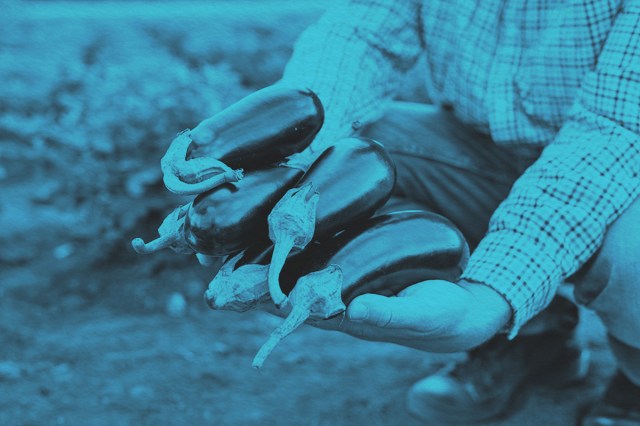
Have you ever noticed that some words and names seem to promise one thing, only to surprise you with something entirely different? For example, consider the confusion of a non-native English speaker when learning that “eggplant” refers to an oblong, purple fruit. The same can be said about grapefruit, which belongs to the citrus family, or navy beans, which are white. Let’s explore the history behind the words to discover why these cleverly named foods aren’t a case of mistaken identity.
Where would modern cuisine and its global inspirations be without chickpeas? Cultivated for at least 10,000 years, this legume has long been a staple in Mediterranean diets — though it has nothing to do with chickens. The word “chickpea” ultimately derives from the Latin word for “pea,” cicer. This is also the origin of the renowned Roman statesman’s name: “Cicero” originated as a surname of someone who grew or sold legumes.
Based on this etymology, the name of this legume translates to “pea peas” (similar to how the incorrect usage of “chai tea” translates to “tea tea”). The modern English word “chickpea” developed in the 18th century from the French pois chiche (the same food), which came from the Latin cicer. Over time, chiche was folk etymologized as “chick” in English, giving way to the current form. Another common name, “garbanzo bean,” is Spanish, deriving from the Basque phrase garau anztu, meaning “dry seed.”
Dragon fruit, with its spiky skin and vibrant pink hue, looks like something from a fantasy novel. But it doesn’t come from dragons (obviously) — it grows on a vining cactus native to Central America. Its scientific name, Hylocereus undatus, refers to its appearance: hyle (Greek for “woody”), cereus (Latin for “waxen”), and the Latin undatus, referring to the wavy edges of its stems. The dragon fruit is also called “pitaya” in many countries around the world.
Its English name, “dragon fruit,” has a mythical backstory. Cultivated in tropical areas around the world, dragon fruit is especially popular in Asia. In the early days of the fruit’s cultivation, merchants spun tales of fierce battles and fire-breathing dragons wherein the fruit would sprout from their final breath. The fruit was a symbol of triumph, presented to emperors as a gift of honor. The name likely stuck around because of the dragon fruit’s scaly appearance.
A versatile staple in dishes such as ratatouille, eggplant parmesan, and baba ghanoush, this glossy purple fruit belongs to the nightshade family. But how did something purple come to be named after an egg? The English name dates back to the 18th century, when a different variety of the fruit — small, white, and oval-shaped — was commonly grown in Europe. These early cultivars looked just like hen’s eggs, and the name stuck.
In British English and some European languages, the purple fruit is called “aubergine,” derived from the Arabic word “al-badinjan,” meaning “the eggplant.” This term originates from ancient words for the fruit, including the Persian “badin-gan” and Sanskrit “vatigagama.” It’s unclear when American English speakers began calling the purple fruit “eggplant,” but seed catalogs in 1825 listed both white and purple versions with that name. At some point in the last 200 years, the white version dropped out of popularity, although it can still be found as a specialty food..
The grapefruit is a large citrus fruit known for its tangy flavor; it’s a natural hybrid of the pomelo (the largest of the citrus fruits) and the sweet orange. It was first discovered in the Caribbean, possibly originating from Barbados during the 17th century. The fruit gained popularity during the 18th century and was soon cultivated throughout tropical regions, though the true origin of its name remains a mystery.
There were many early names for the new citrus; often, names were confused because oranges, grapefruit, pomelos, and other citrus fruits looked so similar. According to the horticulture department at Texas A&M University System, by the 19th century, Jamaican farmers knew the fruit as “grapefruit” because it grows in clusters on trees, much like grapes. However, other sources suggest that the association with grapes originated not from its appearance, but from a Dutch physician named Wouter Schouden, who visited Barbados in 1664 and described the sour fruit as tasting like “unripe grapes.”
What do you call small, white beans commonly used in dips, stews, and soups? One of the most common names is “navy beans,” but their creamy shade is far from blue. As it turns out, the name comes from their long association with the military. These nutrient-dense beans have saved many soldiers and sailors from starvation thanks to their long shelf life, making them a staple in the armed forces’ diet. During the late 19th century, they became closely associated with the U.S. Navy, earning the legumes their contemporary moniker.
But navy beans have been around for thousands of years, long before the U.S. Navy commandeered them. They’re also known as haricots (French for “beans”), pea beans, Yankee beans (in Australia), and Boston beans. The bean was a staple of American Indigenous diets, often prepared with maple syrup and lard. New England colonists modified the recipe to include pork and brown sugar — similar to the modern recipe for Boston baked beans — and soon, giant crocks of baked beans were found in hearths around colonial Boston, earning it the appellation “Beantown.”
Crab apple trees have been cultivated for thousands of years, originating in Central Asia. They gained particular popularity in medieval Britain (and later, colonial America), where their small, tart fruit was used to produce hard cider — a safer alternative to drinking water at the time. During the Middle Ages, the fruit’s English moniker emerged, likely from the adjective “crabbed,” meaning “perverse, wayward” in Middle English, which describes the crab tree’s gnarled and spiny appearance.
Today, “crabbed” is still used as an adjective to describe ill-formed and hard-to-decipher handwriting (“His signature was crabbed and illegible”) or something that is contorted and difficult to understand. So, while the name may evoke thoughts of crustaceans, it actually reflects the tree’s appearance.

















